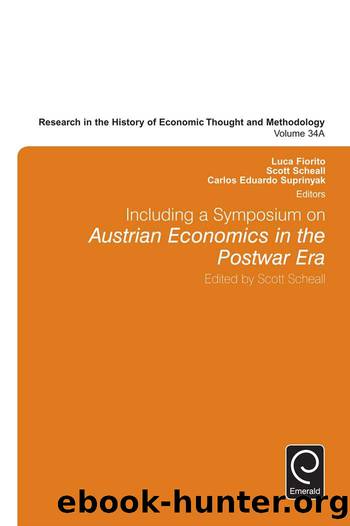Including a Symposium on Austrian Economics in the Postwar Era by Fiorito Luca;Scheall Scott;Suprinyak Carlos Eduardo;

Author:Fiorito, Luca;Scheall, Scott;Suprinyak, Carlos Eduardo;
Language: eng
Format: epub
Publisher: Emerald Publishing Limited
Published: 2016-07-22T00:00:00+00:00
THE INTERWAR YEARS: FROM MISES TO HAYEK
The next phase in the history of Austrian economics would mark both the rise and fall of the school. The Austrian approach was considered cutting-edge throughout the 1920s and into the early 1930s, but was already passé by the end of WWII. This sets up the Kirznerian conundrum and the future shift in the JEL codes discussed in the introduction. Many mainstream economists would argue that by this time all of the important Austrian insights had been incorporated into the body of Neoclassical thought.13 However, as Kirzner (2014) has argued, this was in fact when the Austriansâ most distinctive contributions were made. These contributions were in the fields of money and the trade cycle, economic calculation and the market process, and economic methodology. The main force driving all of these advancements was Ludwig von Mises.14
Böhm-Bawerk unexpectedly died in 1914, and Menger had stopped writing economics long before his death in 1921. This would open the door for the next generation to take over the scientific leadership of Austrian economics. Three names dominate this period in Austrian economics: Joseph Schumpeter, Hans Mayer, and Ludwig von Mises.15 Mises had established himself as one of the leading voices of his generation of economists in the German-language scientific community with the publication of The Theory of Money and Credit (1953 [1912]). Although Misesâ work was more closely allied with the Menger-Böhm-Bawerk approach, Böhm-Bawerk placed greater hope in Joseph Schumpeter for the advancement of economic theory at this time.16 Böhm-Bawerk never developed a theory of money and appears to have not thought highly of Misesâ work (see Garrison, 1999, pp. 119â120; Salerno, 1999b, pp. 41â42).
In his book, Mises advanced the Mengerian and Böhm-Bawerkian approach in many ways. These include the ordinal nature of marginal utility and its application to money, his regression theorem according to which money must originate as a commodity, and his monetary transmission mechanism, which showed that monetary injections were non-neutral. Misesâ analysis stands in stark contrast to the contemporary works of Irving Fisher, who argued for an aggregative approach that relied on holistic concepts such as velocity and the price level, and who believed that money was neutral in the long run. Most importantly, Mises combined Böhm-Bawerkâs capital theory with Knut Wicksellâs natural rate of interest and developed his theory of the trade cycle, later known as Austrian Business Cycle Theory (ABCT). In this theory, Mises argued that the manipulation of money and credit by the central bank distorts interest rates and the structure of production, a process that inevitably leads to a bust.17
A critical part of Misesâs work in The Theory of Money and Credit was a nascent theory of the role of monetary calculation in the coordination of economic affairs. Mises argued that the very phenomena of money presupposes an economic order based on productive specialization and private-property rights in producer as well as consumer goods. Money prices serve as guides to the human mind and as such are the essential tool in the economic calculation of alternative investment activities.
Download
This site does not store any files on its server. We only index and link to content provided by other sites. Please contact the content providers to delete copyright contents if any and email us, we'll remove relevant links or contents immediately.
International Integration of the Brazilian Economy by Elias C. Grivoyannis(91313)
The Radium Girls by Kate Moore(11922)
Turbulence by E. J. Noyes(7937)
Nudge - Improving Decisions about Health, Wealth, and Happiness by Thaler Sunstein(7617)
The Black Swan by Nassim Nicholas Taleb(7011)
Rich Dad Poor Dad by Robert T. Kiyosaki(6406)
Pioneering Portfolio Management by David F. Swensen(6227)
Man-made Catastrophes and Risk Information Concealment by Dmitry Chernov & Didier Sornette(5922)
Zero to One by Peter Thiel(5687)
Secrecy World by Jake Bernstein(4647)
Millionaire: The Philanderer, Gambler, and Duelist Who Invented Modern Finance by Janet Gleeson(4377)
The Age of Surveillance Capitalism by Shoshana Zuboff(4211)
Skin in the Game by Nassim Nicholas Taleb(4163)
Bullshit Jobs by David Graeber(4096)
The Money Culture by Michael Lewis(4078)
Skin in the Game: Hidden Asymmetries in Daily Life by Nassim Nicholas Taleb(3930)
The Dhandho Investor by Mohnish Pabrai(3701)
The Wisdom of Finance by Mihir Desai(3655)
Blockchain Basics by Daniel Drescher(3508)
